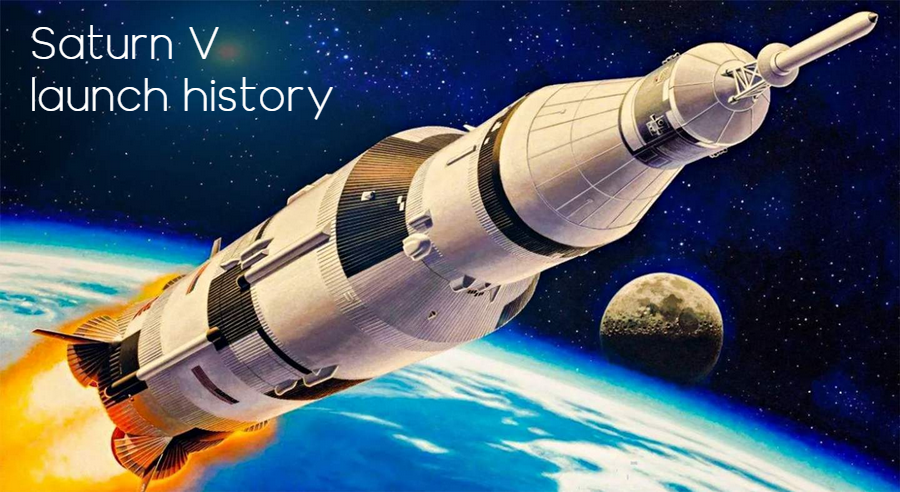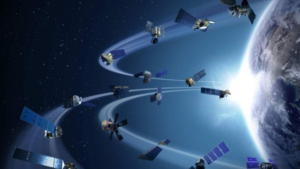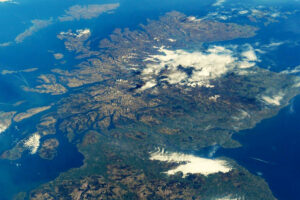The long journey beyond reach: Saturn 5 Launch History
16th May 2022
Saturn V launch vehicle still remains the biggest and most powerful in the world and the only one that delivered humans to the Moon and launched the first American space station Skylab to Low Earth Orbit. And although Saturn is no longer in use, it deserves to be known. Meet Saturn V – the American heavy-lift launch vehicle, the brainchild of legendary aerospace engineer Wernher Von Braun.
History of Saturn launch vehicle creation
1961 was the 4th year of the great space race between the two superpowers. By that time, the Soviets were the first to launch an artificial satellite into orbit, an astronaut and even an interplanetary station to the Moon. The United States was hopelessly lagging behind, so the country needed a response – the kind that would not just overshadow all the USSR successes and close the gap but establish leadership. This gave rise to the Apollo programme (and eventually Saturn 5 rocket launch history), pursuing the goal of landing American astronauts on the Moon.
To achieve this, NASA had everything: a huge budget, along with a strong team of engineers and astronauts ready for any challenges. But it did lack the main thing – a launch vehicle that could go beyond the Earth’s orbit and deliver a ship with astronauts to the Moon. For such a mission, an incredibly powerful carrier was required, and it had to be built.
A year before the launch of Apollo, the Americans had already begun developing a new series of launch vehicles, which were supposed to be a logical continuation of the Jupiter rocket series. The idea belonged to Wernher Von Braun. He called the new series of launch vehicles Saturn, considering that Saturn is the next planet after Jupiter in the solar system. From 1960 to early 1962, NASA’s George Marshall Space Flight Center considered projects for the Saturn C series launch vehicles (Saturn C-1, C-2, C-3, C-4). But eventually, the last three Saturn modifications were abandoned in favour of a more powerful one, Saturn C-5.
In early 1963, NASA finally decided on the scheme for a manned flight to the Moon (the main ship remains in lunar orbit, and the lunar module makes a landing on the surface) and removed the letter C from “Saturn C-5”.
In November 1963, US President John F. Kennedy identified the Saturn V rocket Launch as a game-changer that would allow his country to overtake the Soviets in the space race. This was Kennedy’s last statement, made the day before his death.
Saturn V launcher features
The Saturn three-stage launch vehicle was 110m high (18 m higher than the Statue of Liberty), 10m in diameter and could carry almost three thousand tons. The LEO payload included the Apollo spacecraft and the last stage with the remaining propellant for interplanetary boost, weighing 130 tons (the approximate weight of 10 school buses).
Rocket building was entrusted to the following companies: Boeing (stage 1), North American (stage 2), and McDonnell-Douglas (stage 3). The Saturn launch engines were developed by Rocketdyne. The first Saturn stage was equipped with five F-1 single-chamber rocket engines, which remain the most powerful in the world even today; the second and third Saturn stages – with five and one J-2 engine. F-1s ran on kerosene, J-2s ran on liquid hydrogen. Liquid oxygen served as the oxidising agent. Just think about the scale! The amount of fuel used by the Saturn 5 rocket per launch would be enough for a passenger car to travel around the world 800 times!!
At the same time, such record-breaking characteristics demanded record-breaking costs. One Saturn V launch cost US taxpayers $180-200 million, or about $1.2 billion by today’s standards.
First Saturn V launch
The Saturn V was twice tested without astronauts before it could go on a manned flight. The first Saturn V launch in November 1967 was successful, apart from minor deviations from the calculated estimates. But the second test in April 1968 almost failed. Five minutes into the flight, two second-stage engines shut down. To compensate for the missing speed, the second stage was separated, but due to excessive fuel consumption, the spacecraft failed to reach the calculated orbit. But the trouble didn’t end there. To practice the manoeuvre of sending the ship with astronauts to the Moon, the 3rd stage engine had to be turned on again; however, this did not happen. To continue the Saturn launch mission, the engine of the lunar ship was turned on. Eventually, it worked 7 minutes longer than expected and used up almost all the fuel, jeopardising the spacecraft’s return to Earth. The mission was aborted, and the spacecraft landed 90km away from the calculated point.
The first manned flight to the Moon was called Apollo 8 and took place on 21st December 1968. The spacecraft with three astronauts on board entered the lunar orbit on 24th December and remained on it for 20 hours, flying around the Moon 10 times. On 27th December, Apollo 8 entered the Earth’s atmosphere and successfully splashed down in the Pacific Ocean. The expedition lasted six days and 3 hours.
After that, Saturn 5 launched as part of the Apollo mission nine more times, and all launches were successful. Thanks to it, US astronauts visited the surface of the Moon six times. Only the Apollo 13 mission failed, but this had nothing to do with the launch vehicle – even though there were some difficulties with the Saturn start. At 5 minutes 30 seconds into the flight, the central engine of the second stage turned off – 2 minutes 12 seconds earlier than planned. The flight was not aborted, and the team decided to run four side engines for 34 extra seconds to compensate for the second stage. As a result, the spacecraft’s final speed and the parameters of the orbit have undergone minimal changes that did not affect the mission course.
Video of the very first Saturn V launch
List of Saturn V launches (1967-1973)
|
Mission |
Launch date (UTC) |
Kennedy SC Pad |
Notes |
Mission Result |
|
Apollo 4 |
November 9, 1967 12:00:01 |
39A |
First uncrewed, all-up test flight; complete success. |
Success |
|
Apollo 6 |
April 4, 1968 12:00:01 |
39A |
Second uncrewed test flight; J-2 engine problems caused early shutdown of two engines in second stage, and prevented third stage restart. |
Partially failed |
|
Apollo 8 |
December 21, 1968 12:51:00 |
39A |
First crewed flight; first trans-lunar injection of Apollo command and service module. |
Success |
|
Apollo 9 |
March 3, 1969 16:00:00 |
39A |
Crewed low Earth orbit test of complete Apollo spacecraft with the Lunar Module (LM). |
Success |
|
Apollo 10 |
May 18, 1969 16:49:00 |
39B |
Second crewed trans-lunar injection of complete Apollo spacecraft with LM; Only Saturn V launched from Pad 39B. |
Success |
|
Apollo 11 |
July 16, 1969 13:32:00 |
39A |
First crewed lunar landing, at Sea of Tranquility. |
Success |
|
Apollo 12 |
November 14, 1969 16:22:00 |
39A |
Vehicle was struck twice by lightning shortly after liftoff, no serious damage. Precision crewed lunar landing, near Surveyor 3 at Ocean of Storms. |
Success |
|
Apollo 13 |
April 11, 1970 19:13:03 |
39A |
Severe pogo oscillations in the second stage caused early center engine shutdown; guidance compensated by burning remaining engines longer. Third crewed lunar landing mission was aborted by service module failure. |
Partially Success |
|
Apollo 14 |
January 31, 1971 21:03:02 |
39A |
Third crewed lunar landing, near Fra Mauro, Apollo 13’s intended landing site. |
Success |
|
Apollo 15 |
July 26, 1971 13:34:00 |
39A |
Fourth crewed lunar landing, at Hadley–Apennine. First extended Apollo mission, carrying lunar orbital Scientific Instrument Module and Lunar Roving Vehicle. |
Success |
|
Apollo 16 |
April 16, 1972 17:54:00 |
39A |
Fifth crewed lunar landing, at Descartes Highlands. |
Success |
|
Apollo 17 |
December 7, 1972 05:33:00 |
39A |
Only night launch. Sixth and final crewed lunar landing, at Taurus–Littrow. |
Success |
|
Skylab 1 |
May 14, 1973 17:30:00 |
39A |
Uncrewed launch of the Skylab orbital workshop, which replaced the third stage, on display at Johnson Space Center. Originally designated for canceled Apollo 18 |
Partially Success |
Last Saturn V launch
After the cancellation of the Apollo 18, 19 and 20 missions “due to the lack of new scientific value at the huge expense of the state budget and taxpayers,” three more Saturn V rockets were still left. Two of them were never used and went to the NASA Johnson Space Center museum, and one with serial number SA-513 was redesigned to launch the Skylab space station. The Saturn 5 third stage was removed and replaced with Skylab.
Saturn V launched Skylab on 14th May 1973. The last Saturn V launch was named Skylab 1. During launch and deployment, the station suffered extensive damage, including the loss of a meteor shield and damage to the solar panel. Debris from the shield became tangled in the solar panel, preventing it from fully deploying and causing a power shortage for the station to operate normally. After this Launch, the main Saturn V launch pad Kennedy Space Center 39A was suspended, and the next three Skylab missions were already flown using the Saturn IB from launch pad 39B.
Even though Saturn V was never launched again, this launch vehicle still remains the largest in terms of size, mass, power and payload capacity, surpassing even the SpaceX Falcon Heavy.






Thank you for your comment! It will be visible on the site after moderation.